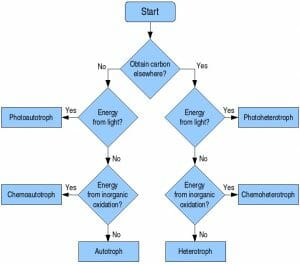There are two things that make chemoheterotrophic bacteria unique. They are unable to make their own food (like autotrophs do) so they get their energy from the oxidation of inorganic minerals in their environment. Also, these bacteria cannot make organic molecules from inorganic sources (they cannot “fix” carbon) so they eat other organisms to get the carbon they need.
An example of chemoheterotrophic bacteria is a sub-type called lithotrophic bacteria, also known as “rock eaters” or “stone eaters.” These bacteria are found in underground water sources and on the ocean floor where there are both mineral food sources and organic molecules available. The common food and energy sources for them are dead organic material and elemental sulfur and iron and gases having these elements such as hydrogen sulfide.

The image above is a flowchart that helps determine the trophic category an organism belongs to. It shows that chemoheterotrophs don’t make their own food (they don’t use photosynthesis to fix carbon) and they get their energy from the oxidation of inorganic molecules.
References
- Lithotroph. (n.d.). In Wikipedia. Retrieved September 19, 2017 from https://en.wikipedia.org/wiki/Lithotroph
Chemoheterotrophic Bacteria
No comments:
Post a Comment